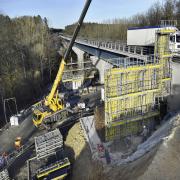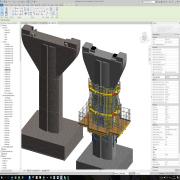
Press Contact
Impressions
Ingenious formwork solution for tight spaces
Vinci Autoroutes, the construction company, relies on the formwork expertise of Doka for the “Viaduc de la Roumer“ viaduct in the Langeais region. The bridge is 249 m long and 80 m wide. The tallest of the three piers measures 20 m. Since the project is built in the middle of a forest area, the topography and close proximity to the existing bridge dictate that the construction work be done in very tight quarters. One of the client’s most important requirements was to achieve a well-balanced appearance. To that end his instructions were to match the shape and concrete surfaces of the new piers and pier heads with the look of the existing ones.
In the process of constructing the piers, the advantages of the framed formwork Framax Xlife come into play to their fullest. Compact repositioning units significantly reduce the need for cranes on the site. The high-quality Xlife sheet and the galvanised and powder-coated steel frames ensure a clean and level concrete finish. It takes ten days for each casting section to be completed. For building the pier heads, Doka combines the Framax Xlife system with the Large-area formwork Top 50 and supporting construction frames. This way it delivers a precisely fitting formwork solution for the design. To keep the on-site assembly work to a minimum, the panels of the large-area formwork were pre-assembled by the Doka Ready-to-Use Service and delivered to the site ready for immediate use. This way the construction company can fully concentrate on executing the construction work. The cycle time for each casting section of the pier heads is between two and three weeks. A total of 2,600 m3 of concrete and 390 tons of reinforcement were used for the piers and pier heads. The abutments on both ends of the bridge were poured using the Framed formwork Framax Xlife.
The combination with the platform system Xsafe plus provides an allround safe workplace during reinforcement and forming tasks. Pre-assembled folding working platforms with integrated side railings are mounted to the framed formwork horizontally and can be repositioned simultaneously with the system. Integrated ladders and manholes also ensure a high level of workplace safety.
Optimised construction site management
All of the construction project planning was realised with the help of Building Information Modelling (BIM). This way any information can be coordinated during all phases of the project lifecycle. BIM not only creates a uniform understanding of the project among all project participants. It also allows for transparent exchange of knowledge in real time, collision tests of the individual trades and optimised construction site management.
Originally formwork planning took place in AutoCAD 2D and was then mapped in BIM. Doka used the construction model of project owner NGE GC as a starting point and modelled a digital twin with the data pertaining to the structure. Advantage: formwork jobs could be simulated virtually on the model even before piers, pier heads and abutments were visible in concrete. This process allowed for optimisations of the formwork solution even before construction. It also provided the opportunity to discover and eliminate inconsistencies early on. The finished model was made available to the client as a file in IFC format. This way he was able to fully exploit the advantages of BIM planning such as process simulation. Another benefit was his ability to access information about all data regarding individual formwork systems and components like article numbers, article descriptions, weight etc.
During the planning phase, Doka Engineers focussed especially on mapping all 20 of the individual casting sections. In his BIM coordination software the client has the option of exactly displaying the time when particular systems and components are used as well as their quantities in each section. “Quite clearly, the important benefit lies with process design and process simulation. This means he can time the use of formwork systems perfectly. Thus, not only is on-site management of construction optimised. This process also ensures fast and smooth construction progress”, says Gerhard Schindler, BIM Project Coordinator at Doka.
Collision test to ensure quality of planning
What’s more, with the 3D model the client is not only able simulate the construction process in the digital twin. He can also perform collision tests of the individual trades quickly and easily and map their interactions. Reinforcement and forming work, material storage location and the use of cranes and personnel must be coordinated perfectly to ensure that construction progresses smoothly. This was an important aspect when the pier heads were formed as space was a precious commodity. It was crucial to see exactly how the formwork tasks could be performed next to the existing bridge without having to make complicated modifications in the course of the construction work.
Added value with virtual tour
Another significant step toward safer and more efficient construction sites is to visualise construction processes. The virtual twin of the construction model was rendered to create a real sense of being on the construction site. The result: Client and site crew can move freely through the formwork model. The goal is to create a comprehensive overview of the site and thus a better understanding of the construction process. The model can be distributed as an executable application or web-based version via link.
Doka and project owner NGE GC are able to look back at many years of cooperation and continue their collaboration as partners with the Viaduc de la Roumer project.
“We are particularly happy that we are able to support our customer in this project with a 3D model, an ingenious formwork solution and a video of a flight from every angle of the site. This way we can significantly contribute to improved construction site management and safe planning”, so Bodin Louis-Gonzague, Head of Engineering Doka Nantes.
Construction work has been in full swing since April 2018. Completion of the piers, pier heads and abutments is scheduled for May 2019. It is followed by the construction of the deck before the bridge is opened for traffic officially in January 2020.
Project Owner: NGE GC
Construction company: VINCI Autoroutes
Architecture: ARCADIS
Formwork planning: Doka Nantes,
Doka Paris, Doka Competence Center VDC/BIM
Construction start: April 2018
Construction completed: May 2019
Opening: January 2020
Services: Formwork planning,
3D BIM model in IFC format
This could also be of interest for you:
Do you have any questions on the article? Get in touch with us!




